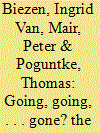| Srl | Item |
| 1 |
ID:
100843


|
|
|
|
|
| Publication |
2010.
|
| Summary/Abstract |
We restate and clarify the idea of the "cartel party," a concept that has found considerable traction in studies of parties throughout the democratic world, including those far from the original research site and data on which the cartel model was based. The cartel party thesis holds that political parties increasingly function like cartels, employing the resources of the state to limit political competition and ensure their own electoral success. The thesis has been subject to varied empirical testing and to substantial theoretical evaluation and criticism. Against this background, we look again at the cartel party thesis in order to clarify ambiguities in and misinterpretations of the original argument. We also suggest further refinements, specifications and extensions of the argument. Following a background review of the original thesis, we break it down into its core components, and then clarify the terms in which it makes sense to speak of cartelization and collusion. We then go on to explore some of the implications of the thesis for our understanding of contemporary democracies and patterns of party organization and party competition and we identify a possible agenda for future research in party scholarship.
|
|
|
|
|
|
|
|
|
|
|
|
|
|
|
|
| 2 |
ID:
111498


|
|
|
|
|
| Publication |
2012.
|
| Summary/Abstract |
This article offers an overview of levels of party membership in European democracies at the end of the first decade of the twenty-first century and looks also at changes in these levels over time, comparing party membership today with figures from both 1980 and the late 1990s. While relying primarily on the direct and individual membership figures as reported by the parties themselves, the fit of the data with survey data is explored and it is concluded that the two perform well in terms of convergent validity. The differences between large and small democracies are examined, as well as old and new democracies, and it is found that levels of party membership are related to both the size and age of the democratic polity in question. Finally, the implications of the patterns observed in the membership data are discussed, and it is suggested that membership has now reached such a low ebb that it may no longer constitute a relevant indicator of party organisational capacity.
|
|
|
|
|
|
|
|
|
|
|
|
|
|
|
|